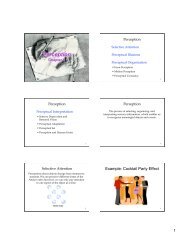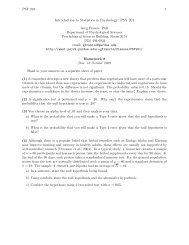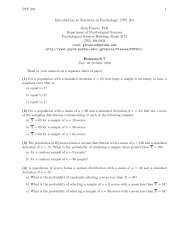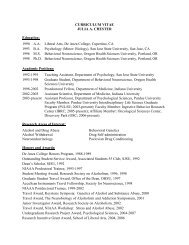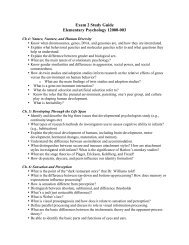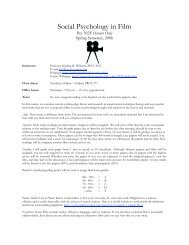Introduction to Cognitive Psychology - Department of Psychological ...
Introduction to Cognitive Psychology - Department of Psychological ...
Introduction to Cognitive Psychology - Department of Psychological ...
Create successful ePaper yourself
Turn your PDF publications into a flip-book with our unique Google optimized e-Paper software.
Greg Francis 1/7/11Analogy!! The solution is the same!!split up the army and have them converge <strong>to</strong>the fortress from different parts <strong>of</strong> the kingdom!! Glick & Holyoak (1980)!!subjects read s<strong>to</strong>ries like these and wereasked <strong>to</strong> solve the problems!!even when shown one solution and <strong>to</strong>ld that itcould be applied by analogy <strong>to</strong> another!!subjects used analogies only 20% <strong>of</strong> the timeAnalogy!! Analogies are actually very difficult <strong>to</strong> apply!!need <strong>to</strong> identify what is common between twoproblems!! Analogies are <strong>of</strong>ten applied after twoproblems are solved and well unders<strong>to</strong>od!!it is then easier <strong>to</strong> see what is common!! One <strong>of</strong> the problems handed out can besolved by analogy <strong>to</strong> these two problemsPurdue UniversityPurdue UniversitySet effects!! “Set” refers <strong>to</strong> “mind set” (or something likethat)!!negative set: bias <strong>to</strong>ward solving a problem makesit more difficult!!positive set: bias <strong>to</strong>ward solving a problem makesit easier!! You can be biased by lots <strong>of</strong> things!!problem statement!!previous methods <strong>of</strong> reaching solution!!general knowledgePurdue University!! Buddhist monk problemPast experience!! One morning, exactly at sunrise, a Buddhist monk began <strong>to</strong>climb a tall mountain. The narrow path, no more than a foo<strong>to</strong>r two wide, spiraled around the mountain <strong>to</strong> a glitteringtemple at the summit. The monk ascended the path with anaverage speed <strong>of</strong> 3 mph. He reached the temple shortlybefore sunset. After several days <strong>of</strong> fasting and meditationhe began his journey back along the same path, starting atsunrise and walking an average speed <strong>of</strong> 5 mph. Is there aspot along the path that the monk occupied on both trips atprecisely the same time <strong>of</strong> day?Purdue UniversitySelf-imposed limits!! Nine dots problem!!Draw four straight lines, passing through all nine<strong>of</strong> these dots, without lifting your pencil from thepage.Set effects: Representation!! Mutilated chessboard!!62 squares remain!!can 31 dominoes cover them?!! Easy solution!Purdue UniversityPurdue UniversityPSY200 <strong>Cognitive</strong> <strong>Psychology</strong> 3





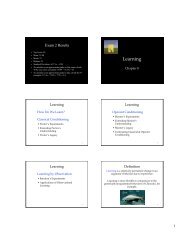
![Exam 4 Study Guide[1]](https://img.yumpu.com/45196739/1/190x245/exam-4-study-guide1.jpg?quality=85)
